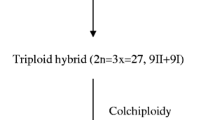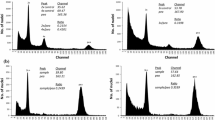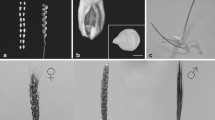Abstract
InSedum rupestre L. a polyploid series (x = 16) occurs in which aneuploid chromosome numbers and odd levels of ploidy prevail. The most common and widely distributed cytotype,S. rupestre subsp.rupestre, is 2n = 112. Plants resemblingS. rupestre subsp.rupestre can be obtained by hybridizing the tetraploid cytotypes ofS. forsterianum Sm. (2n = 48) andS. rupestre subsp.erectum 't Hart (2n = 64). Comparison of these artificial hybrids with their parents and a large number of plants ofS. rupestre subsp.rupestre (2n = 112) from nature showed thatS. rupestre subsp.rupestre and the artificial hybrids are morphologically indistinguishable, and intermediate betweenS. forsterianum andS. rupestre subsp.erectum. MorphologicallyS. rupestre subsp.rupestre is closer to subsp.erectum than toS. forsterianum. Chloroplast DNA restriction patterns ofS. rupestre subsp.rupestre, however, resembleS. forsterianum more closely. The combined results of the hybridization experiments, the analysis of the cpDNA restriction patterns, and the morphological variation indicate the allopolyploid origin ofS. rupestre subsp.rupestre.
Similar content being viewed by others
References
Bock, H. H., 1974: Automatische Klassifikation. — Göttingen: Vandenhoek & Ruprecht.
Bouvet, G., 1882–1883: Revisions des Sedums (groupereflexum) de l'herbierBoreau. — Rev. Bot. Soc. France Bot.1: 156–160.
Castroviejo, S., Calvo, R., 1981: Datos citotaxonomicos enSedum serieRupestria Berger. — Anales Jard. Bot. Madrid38: 37–50.
Doyle, J. F., Doyle, J. L., Brown, A. H. D., Grace, J. P., 1990: Multiple origins of polyploids in theGlycine tabacina complex inferred from chloroplast DNA polymorphism. — Proc. Natl. Acad. Sci. USA87: 714–717.
Favarger, C., Welter, A., 1979: Sur la présence en Corse d'hybrides entreSempervivum montanum L. etS. arachnoideum L. — Bull. Soc. Bot. France126: 103–109.
Fröderström, H., 1932: The genusSedum L. 3. — Acta Horti Gotob. app.7: 1–125.
Harlan, J. R., DeWet, J. M., 1975: OnO. Winge and a prayer: the origins of polyploidy. — Bot. Rev.41: 361–390.
Hart, H. 't, 1972: Chromosome numbers in the seriesRupestria Berger of the genusSedum L. — Acta. Bot. Neerl.21: 428–435.
Hart, H. 't, 1978: Biosystematic studies in theacre-group and the seriesRupestria Berger of the genusSedum L. (Crassulaceae). — Utrecht: Thesis.
Hart, H. 't, 1987: Natural hybrids inSedum (Crassulaceae). 1. Two new hybrids ofS. seriesRupestria and a new locality ofS. ×brevierei. — Bot. Jahrb. Syst.109: 1–16.
-Jarvis, C. E., 1993: Typification ofLinnaeus' names of European species ofSedum subgenusSedum (Crassulaceae). — Taxon42 (in press).
Hébert, L. P., 1983: Analyse d'un complexe chromosomique en Mediterranee:Sedum ser.Rupestria Berger emend. — Rev. Cytol. Biol. Veget. Bot.6: 179–224.
Hogeweg, P., 1976a: Iterative character weighing in numerical taxonomy. — Comput. Biol. Med.6: 199–211.
Hogeweg, P., 1976b: Topics in biological pattern analysis. — Utrecht: Thesis.
Hogeweg, P., Hesper, B., 1981: Oligothetic characterisation of clusters. — Pattern Recognition14: 131–136.
Linnaeus, C., 1753: Species plantarum 1. — Stockholm.
- 1755: Flora Suecica. 2nd edn. — Stockholm.
Löve, A., Löve, D., 1985:Crassulaceae. — InLöve, A., (Ed.): Chromosome number reports 87. — Taxon34: 346–351.
Maniatis, T., Fritsch, E. F., Sambrook, J., 1982: Molecular cloning. A laboratory manual. — New York: CSH.
Nei, M., Li, W. H., 1979: Mathematical model for studying genetic variation in terms of restriction endonucleases. — Proc. Natl. Acad. Sci. USA76: 5269–5273.
Nei, M., Tajima, F., Tateno, Y., 1983: Accuracy of estimated phylogenetic trees from molecular data. 2. Gene frequency data. — J. Mol. Evol.19: 153–170.
Nijs, T. P. M. den, Peloquin, S. J., 1977: 2n Gametes in potato species and their function in sexual polyploidization. — Euphytica26: 585–600.
Sandbrink, J. M., Vellekoop, P., Ham, R. C. H. J. van, Brederode, J. van, 1989: A method for evolutionary studies on RFLP of chloroplast DNA applicable to a large range of plant species. — Biochem. Syst. Ecol.17: 45–49.
Sneath, H. A., Sokal, R. R., 1973: Numerical taxonomy. — San Francisco: Freeman.
Soeda, T., 1944: A cytological study on the genusSedum, with remarks on the chromosome numbers of some related plants. — J. Fac. Sci., Hokkaido Imp. Univ., ser. 5 Bot.,5: 221–231.
Soltis, D. E., Soltis, P. S., 1989: Allopolyploid speciation inTragopogon: insights from chloroplast DNA. — Amer. J. Bot.76: 1119–1124.
Tateno, Y., Nei, M., Tajima, F., 1982: Accuracy of estimated phylogenetic trees from molecular data. 1. Distantly related species. — J. Mol. Evol.18: 387–404.
Toyohuku, T., 1935: Chromosome numbers inSedum. — Jap. J. Genet.11: 316–317.
Uhl, C. H., 1976: Chromosomes, hybrids and ploidy ofSedum cremnophila andEcheveria linguifolia (Crassulaceae). — Amer. J. Bot.63: 806–820.
Uhl, C. H., 1982:Crassulaceae. — InMoore, D. M., (Ed.): Flora Europaea check-list and chromosome index. — Cambridge: Cambridge University Press.
Ward, J. H., 1963: Hierachical grouping to optimise an objective function. — J. Amer. Stat. Ass.58: 236–244.
Author information
Authors and Affiliations
Additional information
Natural hybrids inSedum (Crassulaceae) 4.
Rights and permissions
About this article
Cite this article
Hart, H.'., Sandbrink, J.M., Csikos, I. et al. The allopolyploid origin ofSedum rupestre subsp.rupestre (Crassulaceae). Pl Syst Evol 184, 195–206 (1993). https://doi.org/10.1007/BF00937435
Received:
Revised:
Accepted:
Issue Date:
DOI: https://doi.org/10.1007/BF00937435




